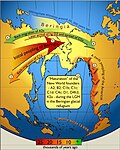Ancient Beringian
The Ancient Beringians are the earliest known population of North America. They migrated from Beringia into Alaska sometime before 11,500 years ago. They separated from other Paleo-Indians about 20,000 years ago. The discovery of an "Ancient Beringian" genome from the remains of two infants dated to 11,500 years ago was announced in January 2018.[1][2] The Ancient Beringians remained in the Arctic until they either became extinct or amalgamated with the Dene about five to six thousand years ago.
The Ancient Beringian were hunter-gatherers. They ate wild plants and wild animals. Some of the animals they ate were salmon,[3][4] ptarmigan, and ground squirrels.[5]
Ancient Beringian Media
References
- ↑ Moreno-Mayar, J. Víctor; Potter, Ben A.; Vinner, Lasse; Steinrücken, Matthias; Rasmussen, Simon; Terhorst, Jonathan; Kamm, John A.; Albrechtsen, Anders; Malaspinas, Anna-Sapfo; Sikora, Martin; Reuther, Joshua D.; Irish, Joel D.; Malhi, Ripan S.; Orlando, Ludovic; Song, Yun S.; Nielsen, Rasmus; Meltzer, David J.; Willerslev, Eske (2018), "Terminal Pleistocene Alaskan genome reveals first founding population of Native Americans", Nature, Macmillan Publishers Limited, 553 (7687): 203–207, doi:10.1038/nature25173, PMID 29323294, S2CID 4454580, retrieved January 3, 2018
- ↑ Price, Michael (January 3, 2018), "Ancient Americans arrived in a single wave, Alaskan infant's genome suggests", Science, American Association for the Advancement of Science, 359, Issue 6371
- ↑ Horne, Naomi (September 21, 2015). "Earliest evidence of ancient North American salmon fishing verified". University of Alaska Fairbanks. Archived from the original on January 8, 2018. Retrieved January 7, 2018.
- ↑ Halffman, Carrin, "Human use of Salmon in North America at 11,500 years ago", Proceedings of the National Academy of Sciences, archived from the original on January 1, 2018, retrieved January 7, 2018
- ↑ Wren, Kathy (February 24, 2011). "Science: Child's Cremation Site Reveals Domestic Life in Paleoindian Alaska". American Association for the Advancement of Science. Retrieved January 7, 2018.
